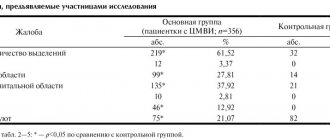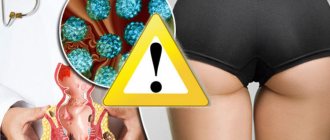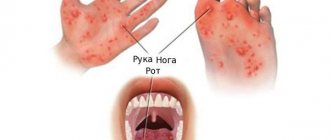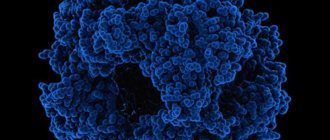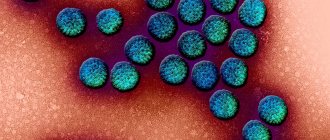The presence of a cell membrane combines chlamydia with bacteria - this allows the use of antibiotics to treat chlamydia.
Tropism to the epithelium of certain organs (genitourinary organs, conjunctiva).
Having a unique life cycle.
Life cycle of chlamydia
Chlamydia exists in the body in 2 forms: elementary bodies (EB) - or extracellular and infectious bodies. Reticular bodies (RT) are the intracellular form of the pathogen. ETs penetrate into the epithelial cell and form a colony. RTs (inclusions), which, using the energy resources of the host cell, multiply, passing first into the so-called intermediate bodies, and then into new EBs, which emerge from the destroyed cell into the intercellular space and infect new cells. The entire development cycle lasts 48-72 hours and 200-1000 new ETs are formed in one development phase.
Important notes about the term chlamydia
Humans can be parasitized by 4 types of chlamydia:
1. Chlamydophila pneumoniae - transmitted by airborne droplets and causes respiratory infections;
2. Chlamydophila psittaci - transmitted from birds (often from domestic parrots and pigeons) causes the disease ornithosis - lung damage;
3. Chlamydophila pecorum - transmitted from mice, cattle - causes respiratory infections;
4. Chlamydia trachomatis - divided into the following antigenic serotypes: A,B,Ba,C - causes trachoma, D - K - cause conjunctivitis and urogenital infections, L1,L2,L3 - cause lymphogranuloma venereum.
We will consider chlamydia, which causes urogenital diseases.
ROUTES OF TRANSMISSION AND CONDITIONS OF INFECTION
The incubation period is from 2 weeks to 1 month. The main route of infection is vaginal, oral or anal sexual contact. Children can become infected when a fetus passes through the birth canal of a mother with chlamydia. Contact-household transmission is also possible (it has been established that chlamydia remains infective on household items, including cotton fabrics, for up to 2 days at a temperature of 18-19 degrees).
SYMPTOMS OF CHLAMYDIOSIS
The entire course of chlamydia in humans can be divided into the following stages: primary infection, recurrent course or persistence, self-healing, development of complications.
PRIMARY INFECTION
After an incubation (hidden) period, the duration of which depends on the amount of chlamydia that has entered the body and the state of the body’s local immune defense (on average from 7 to 20 days), the first clinical symptoms of the disease appear. Due to the fact that chlamydia affects only certain cells - the columnar epithelium - chlamydia is characterized by a favorite localization - i.e. colonization and reproduction of chlamydia in certain human organs. These are: the mucous membranes of the urethra, cervical canal, pharynx and conjunctiva of the eye, rectum.
In addition, in the first months of life, columnar epithelium is present in the bronchi of the newborn, subsequently being replaced by ciliated epithelium. Based on the above, the main manifestations of chlamydia during primary infection: Chlamydial urethritis in men: the most common and main form of manifestation of chlamydia in men. Infection of the urethra with chlamydia occurs during vaginal, oral and anal sexual intercourse with a patient with chlamydia. It manifests itself as scanty mucopurulent (milky) discharge, often detected only in the morning after massage of the urethra. There is practically no redness and swelling of the “urethral sponges”, there are no subjective disorders (pain, cramping). In most cases, there is mild itching in the urethral area. In women, the urethra is rarely affected. Chlamydial endocervicitis and (or) cervicitis in women: the most common and main form of manifestation of chlamydia in women. Infection of the cervical canal with chlamydia occurs during vaginal sexual contact with a patient with chlamydia (infection is also possible during oral sex - cunnilingus). It manifests itself as scanty mucopurulent discharge, which the sick woman does not notice. There are no subjective symptoms (pain). Chlamydial proctitis: an often underdiagnosed but common form of primary chlamydia. Infection occurs during anal and oro-anal sexual intercourse; in women, transmission from the genitals is possible in the presence of heavy discharge. There are no external signs. The diagnosis is made by rectomanoscopy and the detection of chlamydia in scrapings from the rectal mucosa. In rare cases, due to damage to the rectal mucosa, stool mixed with blood and painful sensations during bowel movements are noted. Chlamydial pharyngitis: also a commonly undiagnosed but common form of chlamydia. Infection occurs through oral-genital and oral-anal contact. Transmission through kissing has not been clearly proven. There is redness in the back of the throat and a sore feeling. Symptoms are not expressed and they are not given importance, both by the patient and often by the doctor. Chlamydial conjunctivitis: infection occurs when the infection is introduced from the genitals through the hands. The mechanism of conjunctivitis in Reiter's disease is not clear. There is lacrimation, redness of the mucous membrane of the conjunctiva of the eye, and less often the presence of mucopurulent discharge. The process is in most cases one-sided. Chlamydial balanoposthitis: most often occurs in the form of circinar balanitis (damage to the glans penis) with clearly defined lesions. Most common in Reiter's disease, involvement of the foreskin is extremely rare. In most cases there are no subjective symptoms.
ASYMPTOMIC COURSE (Persistence of chlamydia)
In some cases, chlamydia persists for a long time in the body in the form of isolated microcolonies on the mucous membranes - the so-called carriage. Clinical, instrumental and laboratory examination does not reveal any signs of organ damage - i.e. a person is clinically healthy; only when using high-precision laboratory diagnostic methods (PCR, culture) are chlamydia detected. This condition is associated with the suppression of the reproduction of chlamydia by the body's immune system; often such carriers are even safe from an epidemiological point of view (i.e., they do not infect sexual partners).
RECURRENT COURSE
If treatment is not started, in most cases the symptoms that arose during the period of primary infection disappear spontaneously and can recur under the influence of various factors. A temporary “truce” appears between the organism and the pathogen. Exacerbation of the disease is manifested by the appearance of symptoms as during primary infection, but in less pronounced and short-term forms. But this does not mean that the presence of chlamydia is harmless to the body. The most characteristic manifestations of the recurrent course of the disease are: chronic fatigue syndrome - associated with the effects of chlamydia activity products on the central nervous system (drowsiness, irritability, depression, fatigue). Due to the negative impact of chlamydia on normal microflora, their role in the occurrence of nonspecific balanoposthitis in men and in the development of bacterial vaginosis in women cannot be ruled out. Also noteworthy is the frequent combination of urogenital candidiasis and chlamydia.
COMPLICATIONS OF CHLAMYDIOSIS
However, in most cases, the recurrent course of the disease leads to the development of various complications. Reiter's disease , or urethro-oculo-synovial syndrome, the most dangerous complication of chlamydia, often leading to disability of the patient (deformation and contracture - "fusion" of the joints) - is characterized by a triad of symptoms: urethritis, conjunctivitis and arthritis. Also with the syndrome, various types of skin lesions and circinar balanoposthitis occur. The mechanism of development has not been fully established; opinions are mainly expressed about the autoimmune nature of the syndrome - the body begins to produce antibodies against its own epithelial cells. If previously Reiter's syndrome was observed only in men, recently cases of the disease have begun to be reported in women. Urethral stricture is a narrowing of the urethra due to cicatricial changes in the urethral mucosa, the only treatment for which is surgery, which does not always have a successful outcome. Orchiepididymitis - leading to a narrowing of the sperm ducts and death of Leydig cells, which leads to the cessation of spermatogenesis (sperm production) and, accordingly, to male infertility. Chronic prostatitis leads to the death of glandular tissue of the prostate gland, narrowing of the prostate ducts and, accordingly, a change in the quantity and quality of prostate secretion, which leads to immobilization and rapid death of sperm. There is also evidence that the synthesis of active testosterone occurs in the prostate gland - i.e. in the presence of chronic prostatitis, due to disruption of this process, the amount of testosterone in the body decreases, which leads to a decrease in potency (disappearance of libido). Pelvic inflammatory disease (PID) in women - chlamydial infection can penetrate the uterus, uterine appendages, fallopian tubes of a woman, causing an inflammatory process there - endometritis, salpingo-oophoritis, salpingitis; chlamydia often causes chronic abdominal pain syndrome in women. A distinctive feature of chlamydia is the formation of scars and adhesions in the fallopian tubes, which is the cause of ectopic pregnancy and tubal infertility.
CHLAMYDIOSIS AND PREGNANCY
In addition to the fact that the presence of chlamydia often leads to premature termination of pregnancy (miscarriages), infection of the fetus during childbirth poses a danger (up to 40%). The main forms of manifestation of chlamydia in newborns (congenital chlamydia): ophthalmochlamydia (20%) - conjunctivitis with inclusions, chlamydial pneumonia of newborns (20-25%), generalized form with damage to the lungs, heart, liver, gastrointestinal tract, encephalopathy with convulsions, apnea (respiratory arrest).
Chlamydial pneumonia of newborns - infection of a newborn with chlamydia during childbirth from a sick mother often leads to pneumonia (pneumonia) with an extremely severe course and high mortality.
FAMILY CHLAMYDIOSIS
It has been established that in families where parents are sick with urogenital chlamydia, up to 30% of children are also affected by this disease. Infection occurs through household means (through hygiene items) or through accidental introduction of infection into the eyes
LABORATORY DIAGNOSTICS
For the purpose of laboratory diagnostics, enzyme-linked immunosorbent assay (ELISA), direct immunofluorescence reaction (DIFR), cultural testing and polymerase chain reaction (PCR) are used. The best results are obtained by combining several diagnostic methods.
TREATMENT OF CHLAMYDIOSIS
Treatment should be prescribed taking into account the duration of the disease, the clinical picture, the location of the lesion, and the presence or absence of complications. Sexual partners are subject to mandatory examination and, if necessary, treatment. During the period of treatment and clinical observation, sexual activity is not recommended, or a condom is used.
Grigoriev D.V. Ch. doctor at MC “Healthy Generation”
Life cycle of chlamydia
Features of the development of chlamydia can be considered using the example of an elementary body. There are no other similar bacteria in nature. The microorganism is born during the process of infection of the host cell by ET. This process is called phagocytosis. Typically, the infection attaches to the nonciliated epithelium of the genital organs of the small pelvis: the mucous membrane of the urethra, endometrium, and fallopian tubes.
The next life cycle of chlamydia after attachment is penetration into the host cell. The bacterium remains inside the cell in a cytoplasmic vacuole. Chlamydia requires cellular ATP for growth and development. The bacterium is protected from death by the vacuole shell. One cell can contain several future microorganisms at once.
The primary body turns into a reproductive body after only 8 hours in the cytoplasm of the cell. It is approximately 3 times more massive than the elementary body. Its main difference is its strong metabolic activity, that is, the bacterium can already divide and multiply. At this stage, chlamydia cannot produce energy on its own, so it feeds on ATP from the host cells. Reticular bodies cannot yet infect; they do not have the opportunity to survive without energy outside the cell.
It takes 8 hours to 24 hours for the bacteria to divide. Reproductive bodies can divide in only up to 12 cycles, with daughter microorganisms becoming smaller, denser and turning into an intermediate form, from which new elementary bodies are subsequently formed. A chlamydia colony completely fills the cell.
The colony is called a chlamydial inclusion and contains both reticular and primary bodies. If observed under a microscope, after three days the microcolony grows to the size of a leukocyte and can be seen. If you observe for another 72 hours, you can see how the colony destroys the cell membrane and hundreds of chlamydia emerge from it. Bacteria begin to infect the entire body. The bodies find new cells, and the life cycle repeats again. It takes 72 hours for the bacteria to complete its cycle. With insufficient nutrition or poor quality therapy, the reproduction process can last from several days to a couple of months.
All types of chlamydia have the same development cycle and similar chemical composition. Elementary and reticular bodies have a three-layer shell.
Chlamydia in the active phase should be treated with antibiotics. It is important to consult a doctor promptly when the first symptoms appear. Follow all doctor's recommendations and do not skip taking medications.


